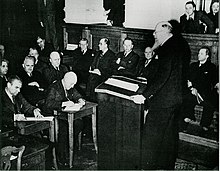Thorvald Stauning
Thorvald Stauning | |
|---|---|
Minister of Defence | |
| In office 31 May 1933 – 4 November 1935 | |
| Prime Minister | Himself |
| Preceded by | Hans Peter Hansen |
| Succeeded by | Alsing Andersen |
| Personal details | |
| Born | 26 October 1873 Copenhagen, Denmark |
| Died | 3 May 1942 (aged 68) Copenhagen, Denmark |
| Political party | Social Democrats |
Thorvald August Marinus Stauning (Danish: [ˈtsʰɒːˌvælˀ ˈstɑwne̝ŋ]; 26 October 1873 in Copenhagen – 3 May 1942) was the first social democratic Prime Minister of Denmark. He served as Prime Minister from 1924 to 1926 and again from 1929 until his death in 1942.
Under Stauning's leadership, Denmark, like some other Western European countries, developed a social welfare state,[1] and though many of his ambitions for Social Democracy were ultimately thwarted in his lifetime by events beyond his control, his leadership through grave times places Stauning among the most admired of twentieth-century Danish statesmen.
The Stauning Alps, a large mountain range in Greenland, were named after him.[2]
Political career
Member of the Folketing
Stauning was trained as a cigar sorter and soon became involved with
Prime Minister of Denmark
He was elected to government as prime minister in 1924 for the
From 1929 he led the successful
In January 1933, Stauning's government entered into what was then the most extensive settlement yet in Danish politics—the

Stauning holds a record in Danish politics, in having successfully sought re-election no less than three times (1932, 1935 (With the famous slogan "Stauning or Chaos"), 1939). However, an attempt to amend the Constitution failed in 1939, as the turnout in the referendum was insufficient to validate the result. This came as a tremendous blow to Stauning, who seemed to lose his previously sure touch for politics thereafter. He reportedly considered resigning in the wake of the referendum failure, but was persuaded to stay on.[6]
Occupation Cabinet
Stauning's second cabinet lasted until Operation
Legacy

Like many other workers' leaders of his generation, such as
He was given a state funeral in 1942, an honour normally not bestowed on Danish prime ministers. He is buried in Copenhagen's
His grandson Søren Goldmann Stauning is a local politician in Them.[7]
References
- ISBN 9783110111309. Retrieved 16 April 2018 – via Google Books.
- ^ "Catalogue of place names in northern East Greenland". Geological Survey of Denmark. Retrieved 18 June 2016.
- ISBN 87-11-11652-8.
- ^ Skou, p. 367
- ISBN 87-02-00361-9.
- ISBN 87-17-05104-5.
- ^ "Staunings barnebarn vil være borgmester". Politiken. May 14, 2001. Archived from the original on September 27, 2022. Retrieved January 11, 2023.

